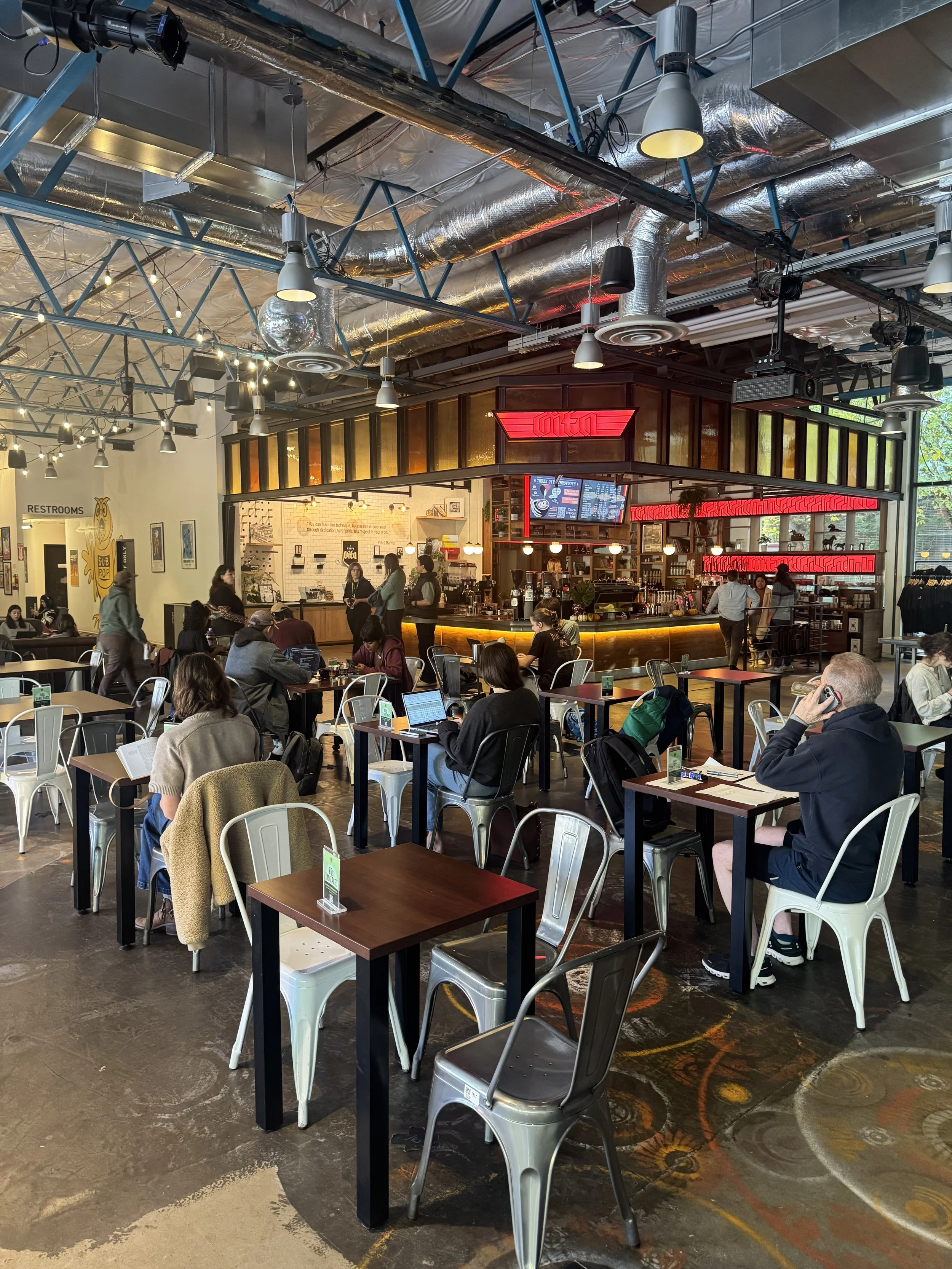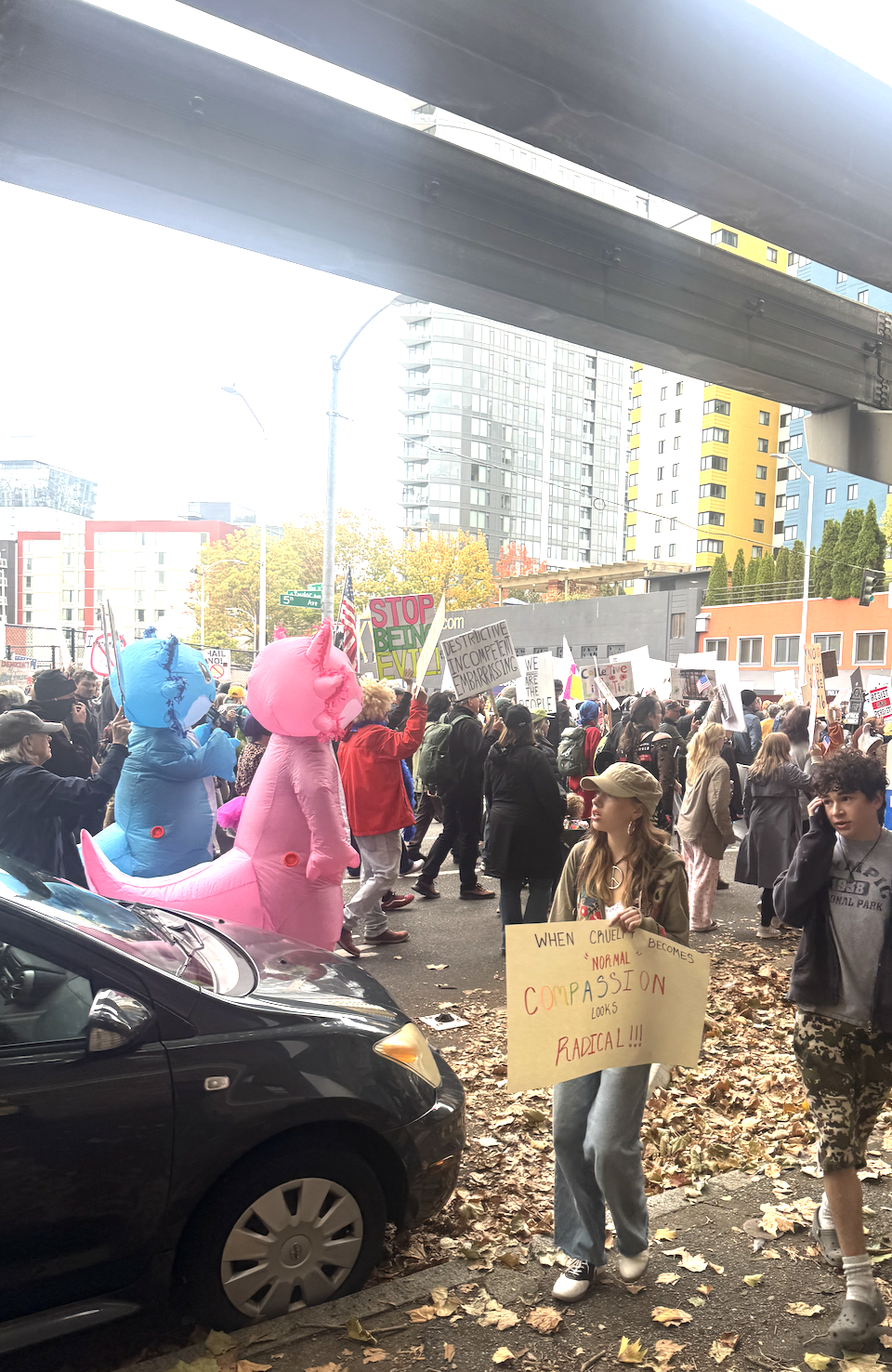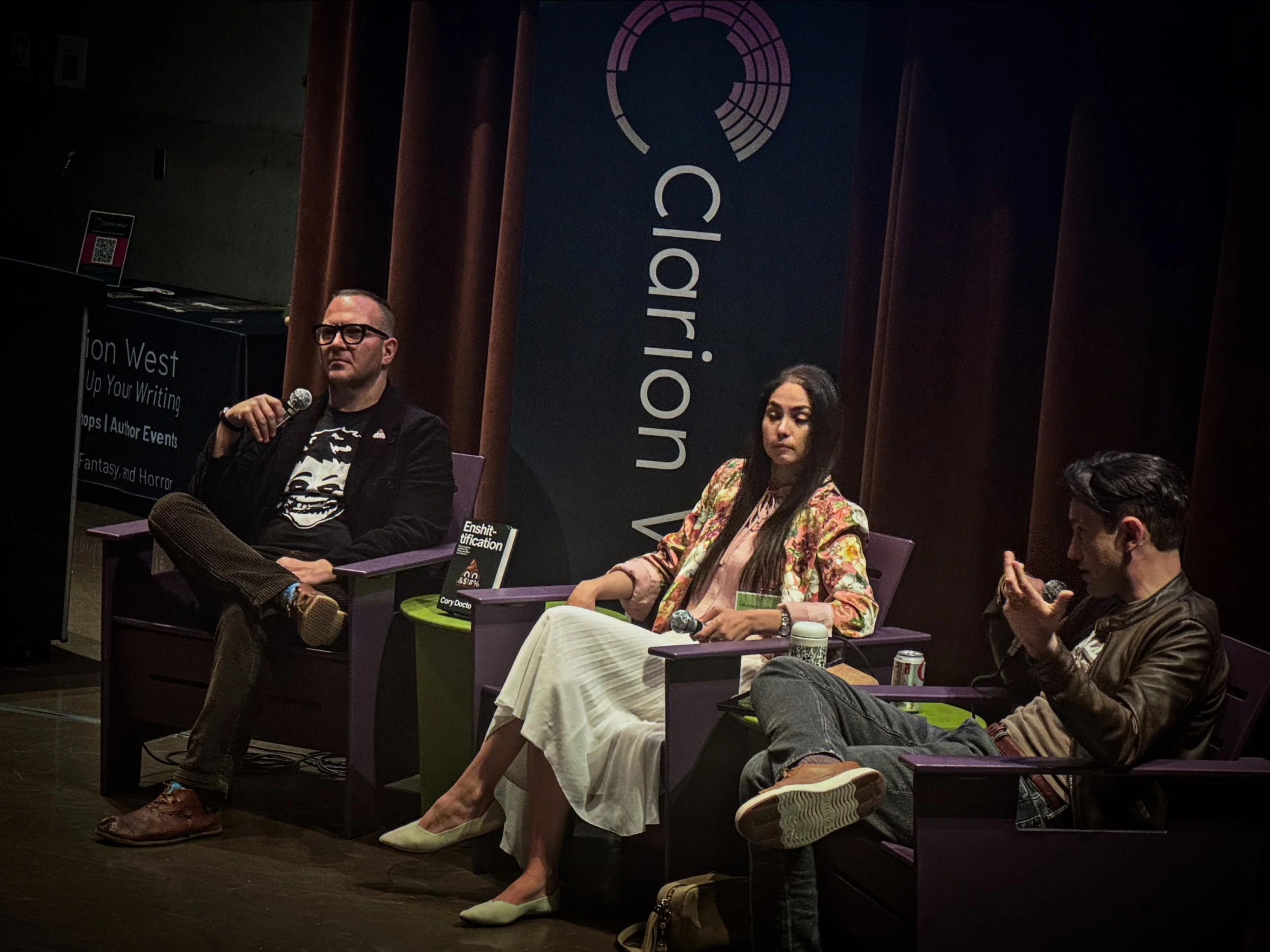I’m All Lost In, #106: The KEXP coffeeshop; the normie protests; the enshittification.
I’m All Lost In…
the 3 things I’m obsessing about THIS week.
#106
1) The KEXP Coffee Shop
KEXP is not my thing: The indie rock confirmation bias loop, the deification of Dad-rock rock. It’s everything I cannot stand about my own Gen-X-dude generation. The dull John (Richards) in the Morning programming that dominates KEXP’s playlists just reiterates the Baby Boom man-splain rhetoric that already suffocates popular music in general.
Certainly, shoutout to DJ Riz for the truly weird electronica on his Sunday night Expansions show and the batch of 7-to-10 pm weeknight world music DJs like Diana Ratsamee; and I still love DJ Lace Cadence’s Amapiano and West African pop show.
But a more important KEXP shoutout from me goes to the Cafe Vita coffeeshop at the station’s Seattle Center headquarters.
This giant swath of cozy, mid-20th century industrial square footage is more public park than coffeeshop. With its bevy of amiable tables, benches, and couches, plus its pop-up record shop all swaddled in floor-to-ceiling windows and a friendly view of the station’s DJ booth, this capacious city living room is the charming go-to destination Seattle Center has needed for years. Catered by Vita’s extensive menu (pour overs, mudhoney mochas, cappuccinos, chai and earl gray teas, orange zest espresso chocolate milks, cold brews, and even tofu banh mis), Cafe Vita at KEXP sets the standard for a coffeeshop-as-an-IRL-student union.
The KEXP community space-as-coffee shop was mobbed, midday Tuesday. 10/21/25.
I could do without the piped-in KEXP programming—with Cult of Personality, U2, and Nirvana in rotation, it’s often hard to discern the difference here from classic rock radio—but in a telecommute year that’s been defined by coffeeshops for me, I’m heartwarmed about this exemplary Seattle option.
2) The Normie No Kings Protests
I’m a longtime protest kid. Dating back to high school, when I had a desk drawer jammed with communist newspapers, I used to take the metro to the National Mall for Rock Against Reagan shows (in my homemade, hand-drawn Clash t shirt) and anti-war-in-El Salvador protests (when I gleefully told a “radio reporter” my name and political affiliation, “radical”). I continued as a reliable protestor at anti-apartheid rallies; anti-Gulf War protests; pro-choice and gay rights parades; anti-Iraq war protests; and more recently at BLM and anti-Trump marches. I’m now like one of those old 1960s demonstrators I used to revere in the summer after 11th grade when I was busy canvassing door to door in the suburbs for the nuclear freeze.
Going back to the 1980s, protests smelled like patchouli, looked like punk shows, and in recent years here in Seattle, after the WTO example, followed a provocative script that predictably led to shoving matches with belligerent police lines at 11th & Pine, a block from the SPD precinct. They invariably culminated in tear gas and our fleeing sneakers. Yes, police escalation was in full force, but the protesters were not blameless; masked, self-proclaimed anarchists were often looking to spark shit.
And as a former reporter let me offer a reality check to the admittedly clever memes that spoof Trump’s antifa paranoia: Antifa is not not a thing. Look, Trump is a moron. And just as with his racist fever dreams about American cities, he’s delusional about antifa. It is not an organized entity nor a terrorist group. Full stop. But like say goths, or the poly kink community, or even YIMBYs today, antifa was, for a time during the Bush II, Obama, and early Trump years, a conscious political ID for many counterculture youth. I interviewed lots of self-identified antifa folks who proudly and disdainfully differentiated themselves from corporate Democrats, KUOW liberals and progressives. And while, yes, it literally stood for anti-fascist, it was in no way associated with WWII vets storming Normandy nor Captain America; they would have derisively spelled Captain America with a K. If you were antifa, you were likely a hardcore vegan who listened to woke speed metal and were ready to go toe to toe with bike cops at protests.
Consider this context for how incredibly awesome I think the most recent peaceful, even playful, No Kings rally was. The tens of thousands of normies who filled family friendly Seattle Center to capacity on Saturday were as wholesome as Cal Raleigh stepping up to bat.
No Kings, Seattle Center, 10/18/25
No Kings, Seattle Center, 10/18/25 …
Time-lapsed video below courtesy of my pal Sara.
Sure, there were placards about loving “dick” and “taters” (just not together), but with lazy hounds on leashes, septuagenarians handing out free box juices and cupcakes, little kids atop dad’s shoulders, American flags aloft, and people in pink and blue animal costumes, the rally looked more like the crowd at Disneyland than Burning Man.
Mainstream resistance is a good thing because it’s hard for Trump to demonize. And as he insists on doing so, he will only create more widespread opposition to his cringe-worthy rule. A reported seven million people in total marched nationwide at 2,700 events on Saturday.
Sure, you can make fun of the lady who was angry that the No Kings organizers didn’t provide child care (!). But this new Trump-era version of mainstream protest, the observable opposite of his Julius and Ethel Rosenberg narrative, matches Trump’s assault on governing “norms” (i.e., not following the American constitution) by starring hundreds of thousands of normies.
No Kings march, Denny Triangle under the Seattle monorail, 10/18/25
3) Cory Doctorow and Enshitification Capitalism
Unlike everyone I know—brains and nerds all—I’d never heard of techie intellectual Cory Doctorow. I had, however, heard of his Electronic Frontier Foundation. Back in the mid-90s when the internet was first coming online, I was a full fledged fan of EFF and their idealistic work to keep cyberspace democratic and corporate-free. Doctorow had me at “I have worked at the EFF since the 1990s” when my pal Erica dragged me to his event at the downtown library last Wednesday night.
To start things off, Doctorow indicted Ronald Reagan as the main cause of today’s unaccountable tech industry, noting that thanks to Reaganomics, big tech was the first business sector to emerge in a post-regulatory age (allowing the concomitant rise of monopoly tech and their business model of enshittifying the internet to keep us stuck in it). Doctorow went on to offer measured and realistic advice for reigning it back in. Kind of scoffing at boycotts, which he didn’t entirely dismiss as performative but provided caution about their limits to prompt the necessary systemic overhaul, he got eloquent about “engaging as a polity,” meaning: the public should organize around policy change.
He was also big on unionizing, noting that once-valuable tech workers, who had been tactically lulled by management into thinking they were indispensable peers alongside their palsy-walsy founder bosses, had lost the leverage they once had and must now turn to the working class solution. Doctorow argues that once rarefied software engineers and data scientists are now just like the expendable Amazon drivers and warehouse workers that are “monitored by AI cameras that take points off if [the driver] looks away from the road,” or the factory worker “who has to pee in a bottle” and is “injured at three times the rate of other warehouse workers.”
Tech workers thought they were founders. They didn’t think they were workers. They thought because their boss would meet them in monthly town hall meetings where they could ask impertinent questions about corporate strategy that their bosses thought that they were peers… Your boss didn’t think you were a peer. Your boss thought you were a problem to solve. And after a half a million layoffs in the tech sector they’re not afraid of you anymore. There’s other workers who will take your job. You can no longer say I refuse to enshittify the thing I missed my mother’s funeral to ship. And you can’t hire someone else to replace me because they’ll just fire you and hire someone else to replace you. And so now is the time to unionize.
Doctorow also pointed to a silver lining of AI enshittification. The smart GPUs that OpenAI, Nvidia, and Apple are flooding us with aren’t going away. And in the imminently pending post-AI bubble crash he theorizes (sounding like he’s describing a hacker-based economy of William Gibson inspired cyber cowboys), GPUs will be up-cycled toward more democratic and humanistic ends.
Tech lefty Cory Doctorow (L) at the Downtown Seattle Library, 10/22/25
Another silver lining Doctorow had up his sleeve: He pointed out that by gutting the historic National Labor Relations Act Trump has unwittingly empowered workers. Doctorow’s reasoning: The National Labor Relations Board (NLRB) was actually established to keep workers in line; the workplace laws they historically enforce were written in the 1930s by an anxious capitalist class to allow unionization as a moderating check on the more potentially disruptive power of workers. In short, the act lays out more laws governing how workers can organize than it does about how management can respond. By abandoning labor law, Trump has, to perhaps his eventual chagrin, given exploited workers a renewed opportunity to fight back.
Quoting Doctorow at length again:
It might feel like a bad time to be unionizing because we no longer have the NLRB. In fact it’s been so illegally denuded of commissioners that it can no longer form a quorum and investigate unfair labor practices.
But here’s the category error Trump is making. Trump thinks the reason we have unions is because we have the National Labor Relations Act. It’s backwards, right? Long before unions were legal we had unions. And the unions’ piece represented by the National Labor Relations Act was brought about because bosses were scared of their workers because militancy had gotten so intense that they sued for peace.
And that peace came in two parts. Part of the National Labor Relations Act describes what your boss can’t do to you. But a lot of the National Labor Relations Act is about what you can’t do to your boss. And one guess about which half of the National Labor Relations Act has been most vigorously enforced. So Trump thinks that we fired the referee and that means the players have to leave the field. He’s wrong. When you fire the referee it means there’s no more rules. There’s a reason fascists attack unions first. It’s because the opposite of fascism is solidarity.
You can watch Doctorow’s impressive talk at the Seattle library on YouTube. Highly recommended.
On a related note, I coincidentally came upon this chart this week. It gets my vote for Graphic of The Week.
And on the direct-trajectory list of “Bad Things,” let’s be sure to acknowledge Trumpism.
Lastly, two follow-ups to some recent posts:
A couple of weeks ago [I’m All Lost In, #104, 10/12/25], I reported that I’d jumped back into my piano set, revisiting a batch of songs I had once learned but forgotten, including the doo-wop number “Earth Angel,” (1954) and the ska standard, “A Message to You, Rudy” (1967). This week, I’ve been having fun checking back in with the revved up blues scale on Big Joe Turner’s early rock & roll song, “Shake, Rattle, and Roll,” (1954), another hazy song from my original set.
And three weeks ago [I’m All Lost In, #103, 10/4/25], I wrote about my obsession with Raymond Chandler; I was re-reading his hard-boiled gem, Farewell, My Lovely (1940).
My dad’s 1976 now-my-copy of Chandler’s The High Window.
Well, I couldn’t get enough of his honorable smart-aleck alter ego, private dick, Philip Marlowe. This past week, once again taking one of dad’s 1976 paperbacks off my shelf, I re-read Chandler’s follow-up, The High Window (1942). This one is even more patiently observant than Farewell, My Lovely as Marlowe details the way weary police detectives light their cigars or the smell of the eucalyptus trees in the darkening foothills. Alongside this minutiae, Marlowe/Chandler simultaneously reports on the nonstop action enumerated in dead bodies. I don’t know how Chandler was able to come up with prose that both lingers and leaps as it takes Marlowe three chapters to leave his apartment and get to his next urgent appointment. But as I revisit his books, I’m discovering this tension may be the crux of Chandler’s pulp magic.
Here’s a snippet of Chandler in form, detailing one of those urgent Marlowe appointments—”about twenty miles north of the pass a wide boulevard with flowering moss … a curving asphalt road drove into the hills” to a private gambling club where “the lobby looked like a high-budget musical” :
The barman moved slowly along the bar to the end where I sat and stood looking away from me, with nothing in his face but pallor. Then he turned to me and said: “Yes, sir?”
“I want to talk to a fellow named Eddie Prue.”
“So?”
“He works here,” I said.
“Works here doing what?” His voice was perfectly level and as dry as sand.
“I understand he’s the guy that walks behind the boss. If you know what I mean.”
“Oh. Eddie Prue.” He moved one lip slowly over the other and made small tight circles on the bar with his bar cloth.







